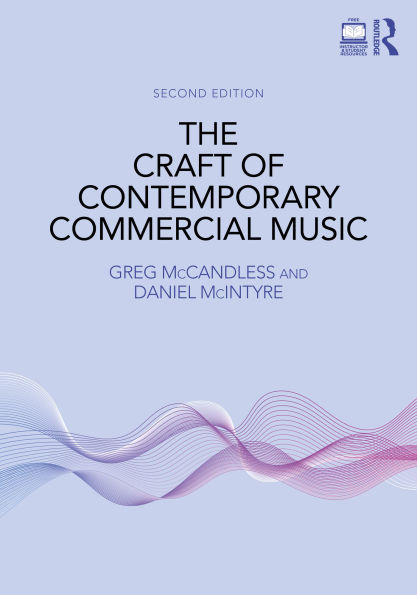The role of the commercial composer has grown to include a wide range of new responsibilities. Modern composers not only write music, but often, they also need to record, and market their own works. The Craft of Contemporary Commercial Music prepares today’s music students for their careers by teaching them to compose their own music, produce it professionally, and sell it successfully. The textbook integrates three areas of concentration—music theory and composition, audio engineering, and music business—allowing students to understand and practice how to successfully navigate each stage of a score’s life cycle from concept to contract. Students will learn how to:
- Translate musical ideas into scores utilizing music theory and composition techniques
- Transform scores into professional audio through the production stages of tracking, sequencing, editing, mixing, mastering, and bouncing
- Market works to prospective clients
The textbook assumes no prior knowledge of music theory or audio topics, and its modular organization allows instructors to use the book flexibly. Exercises at the end of each chapter provide practice with key skills, and online Instructor and Student Resources support the book with video walkthroughs, streaming audio, a glossary, and printable exercise pages. This second edition includes:
-
Enhanced and new images throughout the book
- Updated technology examples, including greater integration of Ableton Live
- Discussions of industry-standard equipment, featuring companies such as Universal Audio, FabFilter, and iZotope
- More focus on popular music examples throughout the book, particularly in the context of music theory
- An expanded section on the music business, with new information on contracts, royalties, and digital play-tracking services
- Exercise answer keys for instructors, new video walkthroughs, and more online resources available at routledgelearning.com/cccm
Combining a grounding in music notation and theory concepts with a foundation in essential technologies, The Craft of Contemporary Commercial Music offers an innovative approach that addresses the needs of students preparing for music careers.
The role of the commercial composer has grown to include a wide range of new responsibilities. Modern composers not only write music, but often, they also need to record, and market their own works. The Craft of Contemporary Commercial Music prepares today’s music students for their careers by teaching them to compose their own music, produce it professionally, and sell it successfully. The textbook integrates three areas of concentration—music theory and composition, audio engineering, and music business—allowing students to understand and practice how to successfully navigate each stage of a score’s life cycle from concept to contract. Students will learn how to:
- Translate musical ideas into scores utilizing music theory and composition techniques
- Transform scores into professional audio through the production stages of tracking, sequencing, editing, mixing, mastering, and bouncing
- Market works to prospective clients
The textbook assumes no prior knowledge of music theory or audio topics, and its modular organization allows instructors to use the book flexibly. Exercises at the end of each chapter provide practice with key skills, and online Instructor and Student Resources support the book with video walkthroughs, streaming audio, a glossary, and printable exercise pages. This second edition includes:
-
Enhanced and new images throughout the book
- Updated technology examples, including greater integration of Ableton Live
- Discussions of industry-standard equipment, featuring companies such as Universal Audio, FabFilter, and iZotope
- More focus on popular music examples throughout the book, particularly in the context of music theory
- An expanded section on the music business, with new information on contracts, royalties, and digital play-tracking services
- Exercise answer keys for instructors, new video walkthroughs, and more online resources available at routledgelearning.com/cccm
Combining a grounding in music notation and theory concepts with a foundation in essential technologies, The Craft of Contemporary Commercial Music offers an innovative approach that addresses the needs of students preparing for music careers.

The Craft of Contemporary Commercial Music
486
The Craft of Contemporary Commercial Music
486Related collections and offers

Product Details
| ISBN-13: | 9781040338032 |
|---|---|
| Publisher: | Taylor & Francis |
| Publication date: | 05/30/2025 |
| Sold by: | Barnes & Noble |
| Format: | eBook |
| Pages: | 486 |
| File size: | 27 MB |
| Note: | This product may take a few minutes to download. |
